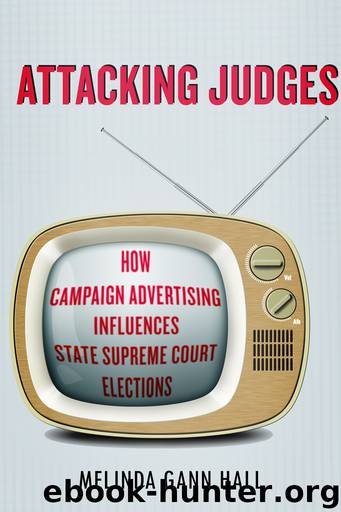Attacking Judges by Hall Melinda Gann

Author:Hall, Melinda Gann. [Hall, Melinda Gann]
Language: eng
Format: epub
Publisher: Stanford University Press
Published: 2014-12-24T16:00:00+00:00
* Means shown for the advertising and spending variables are actual values (airings or dollars) rather than natural logarithms.
As Table 5-1 indicates, ballot roll-off is higher on average in the nonpartisan elections evaluated in this chapter than in the partisan elections, by almost eight percentage points. Nonpartisan elections have an average roll-off rate of 18.2 percent, compared with partisan elections at 10.3 percent.31 These statistics are consistent with other studies (e.g., Dubois 1980; M. G. Hall 2007a; M. G. Hall and Bonneau 2008) identifying substantial gaps in voter participation between nonpartisan and partisan state supreme court elections and with the data reported in Chapter 2.
Table 5-1 also shows that attack airings, contrast airings, and campaign spending per capita are higher on average in partisan elections, although promote airings are used more often in nonpartisan elections (but this difference is rather small). From the perspective of candidate factors, elections for incumbents holding unsafe seats are somewhat more common in the dataset in nonpartisan elections, while races involving newly appointed incumbents and open seats are more typical in partisan elections.
Looking at contextual variations, the nonpartisan elections included in the models are more likely to take place during presidential election years and in district constituencies, compared with partisan elections. Regarding election salience, partisan and nonpartisan elections look fairly similar. Interestingly, average professionalization is higher in partisan elections than nonpartisan elections but not by any significant measure.
Finally, there are some differences in the ways nonpartisan and partisan elections are distributed across the time series. Partisan elections occur relatively evenly across the four election cycles, while nonpartisan elections are clustered more in presidential election years, especially in 2004.
Results
The central purpose of the empirical analysis in this chapter is to assess the impact of attack advertising on ballot roll-off in state supreme court elections and to determine whether these effects are conditioned by the presence or absence of partisan ballots. To this end, I estimated a total of five sets of models (in Tables 5-2, 5-3, 5-4, 5-5, and 5-6) that address this vital question in a systematic way while providing essential robustness checks on the initial results.
Collectively, these results reveal the powerful extent to which highly contentious campaigns and basic institutional arrangements can influence citizen participation in state supreme court elections, in ways that directly contradict the bold assertions of the judicial reform and legal communities and some political scientists.
TABLE 5-2. Televised campaign advertising and ballot roll-off in state supreme court elections, 2002–2008, with controls for presidential election years.
Download
This site does not store any files on its server. We only index and link to content provided by other sites. Please contact the content providers to delete copyright contents if any and email us, we'll remove relevant links or contents immediately.
The Thirst by Nesbo Jo(6458)
Permanent Record by Edward Snowden(5553)
The Myth of the Strong Leader by Archie Brown(5251)
Spare by Prince Harry The Duke of Sussex(4807)
A Higher Loyalty: Truth, Lies, and Leadership by James Comey(4568)
Secrecy World by Jake Bernstein(4408)
Adulting by Kelly Williams Brown(4246)
The Borden Murders by Sarah Miller(4033)
Killers of the Flower Moon by David Grann(3761)
Machine Learning at Scale with H2O by Gregory Keys | David Whiting(3675)
Fear by Bob Woodward(3530)
American Kingpin by Nick Bilton(3513)
The Secret Barrister by The Secret Barrister(3431)
Future Crimes by Marc Goodman(3380)
The Last Girl by Nadia Murad(3349)
Liar's Poker by Michael Lewis(3235)
The House on Mango Street by Sandra Cisneros(3235)
The Social Psychology of Inequality by Unknown(2778)
Graduate Admissions Essays, Fourth Edition: Write Your Way into the Graduate School of Your Choice (Graduate Admissions Essays: Write Your Way Into the) by Asher Donald(2747)
